文件操作管理
- 1、文件打开
- 2、文件的顺序读写
-
- 2.1fputc函数
- 2.2fgetc函数
- 2.3fgets函数
- 2.4fputs函数
- 2.5fprintf函数
- 2.6fcanf函数
- 2.7sprintf函数与sscanf函数
- 2.8print与scanf大家族
- 2.9fwrite函数
- 2.10fread函数
- 3、文件的随机读写
-
- 3.1fseek函数
- 3.2ftell函数
- 3.3rewind
- 4、文件读取结束的判定
-
- 4.1被错误使用的feof
- 5、多文件复制
1、文件打开
- 文件在读写之前应该先打开文件 ,再使用结束之后应该关闭文件*。
- 编写程序时打开文件,都会返回应该
FILE*的指针变量指向该文件,相当于建立了指针和文件的关系。 - 使用
fopen函数来打开文件,fclose来关闭文件。
C
//打开文件
FILE * fopen("文件名","模式");
//关闭文件
int fclose(fopen);| 文件使用方式 | 含义 | 如果指定文件不存在 |
|---|---|---|
| "r"(只读) | 为了输入数据,打开已经存在的文本文件 | 出错 |
| "w"(只写) | 为了输出数据,打开应该文本文件 | 建立一个新的文件 |
| "a"(追加) | 向文本问及那尾添加数据 | 建立一个新的文件 |
| "rb"(只读) | 为了输入数据,打开应该二进制文件 | 出错 |
| "wb"(只写) | 为了输出数据,打开应该二进制文件 | 建立一个新的文件 |
| ab"(追加) | 向一个二进制文件尾添加数据 | 建立一个新的文件 |
| "r+"(读写) | 为了读和写,打开一个文本文件 | 出错 |
| w+"(读写) | 为了读和写,建立⼀个新的文件 | 建立一个新的文件 |
| "a+"(读写) | 打开一个文件,在文件尾进行读写 | 建立一个新的文件 |
| "rb+"(读写) | 为了读和写打开一个二进制文件 | 出错 |
| wb+"(读写) | 为了读和写,新建一个新的二进制文件 | 建立一个新的文件 |
| "ab+"(读写) | 打开⼀个二进制文件,在文件尾进行读和写 | 建立一个新的文件 |
C
/* test.txt */
#include<stdio.h>
int main()
{
//打开文件
FILE *ps = ("test.txt", "w");
//文件操作
if(ps ! = NULL)
{
//写文件
fputs("a", ps);
//关闭文件
fclose(ps);
}
return 0;
}2、文件的顺序读写
| 函数名 | 功能 | 适用于 |
|---|---|---|
| fgetc | 字符输入函数 | 所有输入流 |
| fputc | 字符输出函数 | 所有输入流 |
| fgets | 文本行输入函数 | 所有输入流 |
| fputs | 文本行输出函数 | 所有输入流 |
| fscanf | 格式化输入函数 | 所有输入流 |
| fprintf | 格式化输出函数 | 所有输入流 |
| fread | 二进制输入 | 文件输入流 |
| fwrite | 二进制输出 | 文件输入流 |
上面说的适用于所有输入流一般只适用于标准输入流和其他输入流(如文件输入流);所有输出流一般适用于标准输出流和其他输出流(如文件输出流)
2.1fputc函数
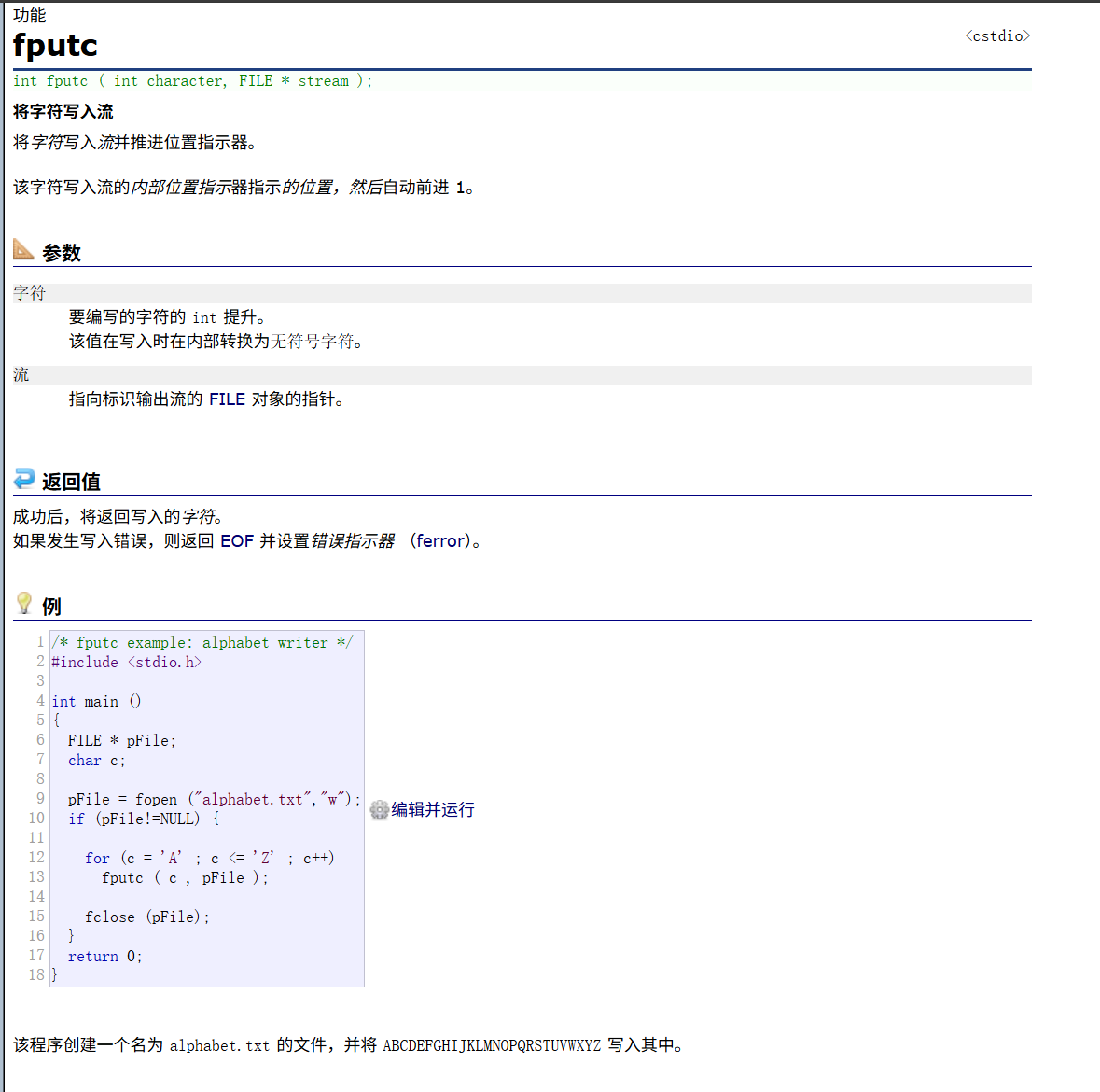
C
int fgetc ( FILE * stream );
C
#define _CRT_SECURE_NO_WARNINGS
#include <stdio.h>
#include <stdlib.h>
int main(void)
{
//打开文件(存在的情况下)
FILE* ps = fopen("test.txt", "w");
if (ps == NULL)
{
perror("fopen");
return 1;
}
int ch = 0;
for (ch = 'a'; ch <= 'z'; ch++)
{
//输入字符
fputc(ch, ps);
}
//关闭文件
fclose(ps);
return 0;
}此时的test.txt文件
abcdefghijklnmopqrstuvwxyz
2.2fgetc函数
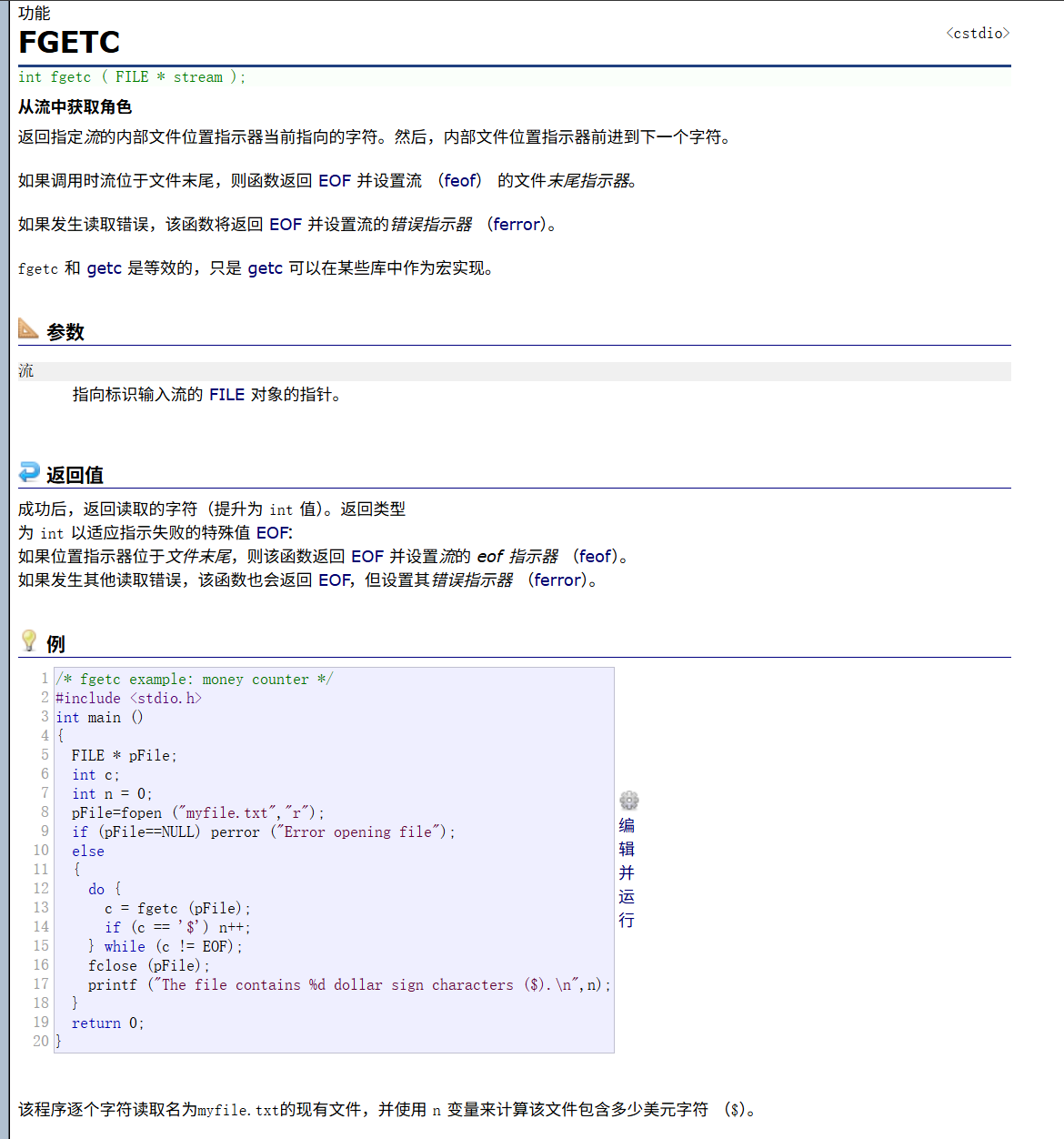
test.txt文件 :
abcdefghizklmnopqrstuvwxyz
C
#define _CRT_SECURE_NO_WARNINGS
#include <stdio.h>
#include <stdlib.h>
int main(void)
{
//打开文件(存在的情况下)
FILE* ps = fopen("test.txt", "r");
if (ps == NULL)
{
perror("fopen");
return 1;
}
//读文件
int ch = 0;
while ((ch = fgetc(ps)) != EOF)
{
printf("%c", ch);
}
//关闭文件
fclose(ps);
return 0;
}屏幕上显示:abcdefghizklmnopqrstuvwxyz
2.3fgets函数
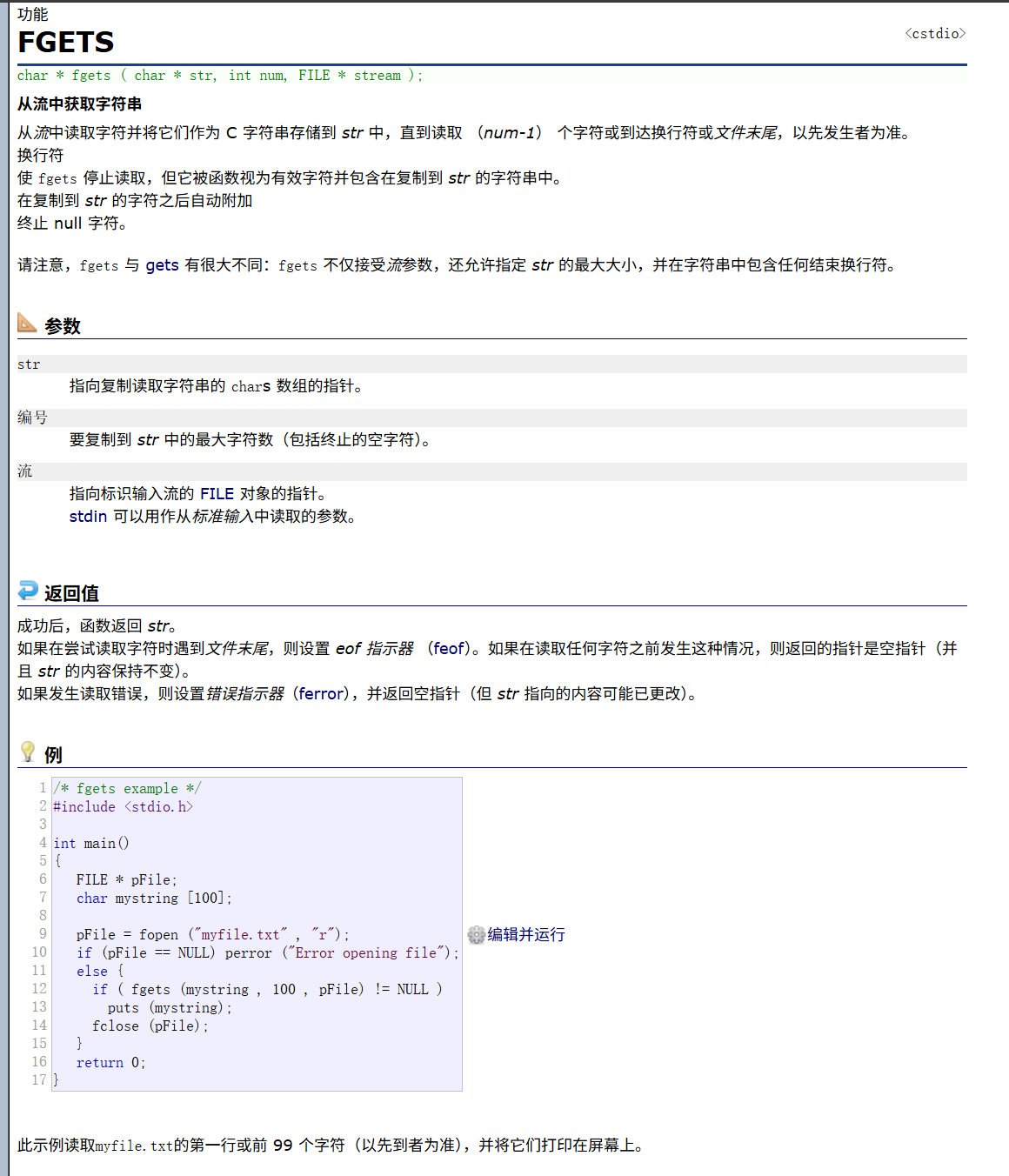
- 当num为10时,第10个会放\0
- 当数组过短,num过大时,会在数组后补上\n,后补\0
- fgets读取方式是一行一行的读
C
#define _CRT_SECURE_NO_WARNINGS
#include <stdio.h>
#include <stdlib.h>
int main(void)
{
//打开文件
FILE* ps = fopen("test.txt", "r");
if (ps == NULL)
{
perror("fopen");
return 1;
}
//读文件
char arr[10] = { 0 };
//最多读19个,再继续往后读,直到遇到\0再换行
while (fgets(arr, 20, ps) != NULL)
{
fgets(arr, 10, ps);
}
//关闭文件
fclose(ps);
ps = NULL;
return 0;
}2.4fputs函数
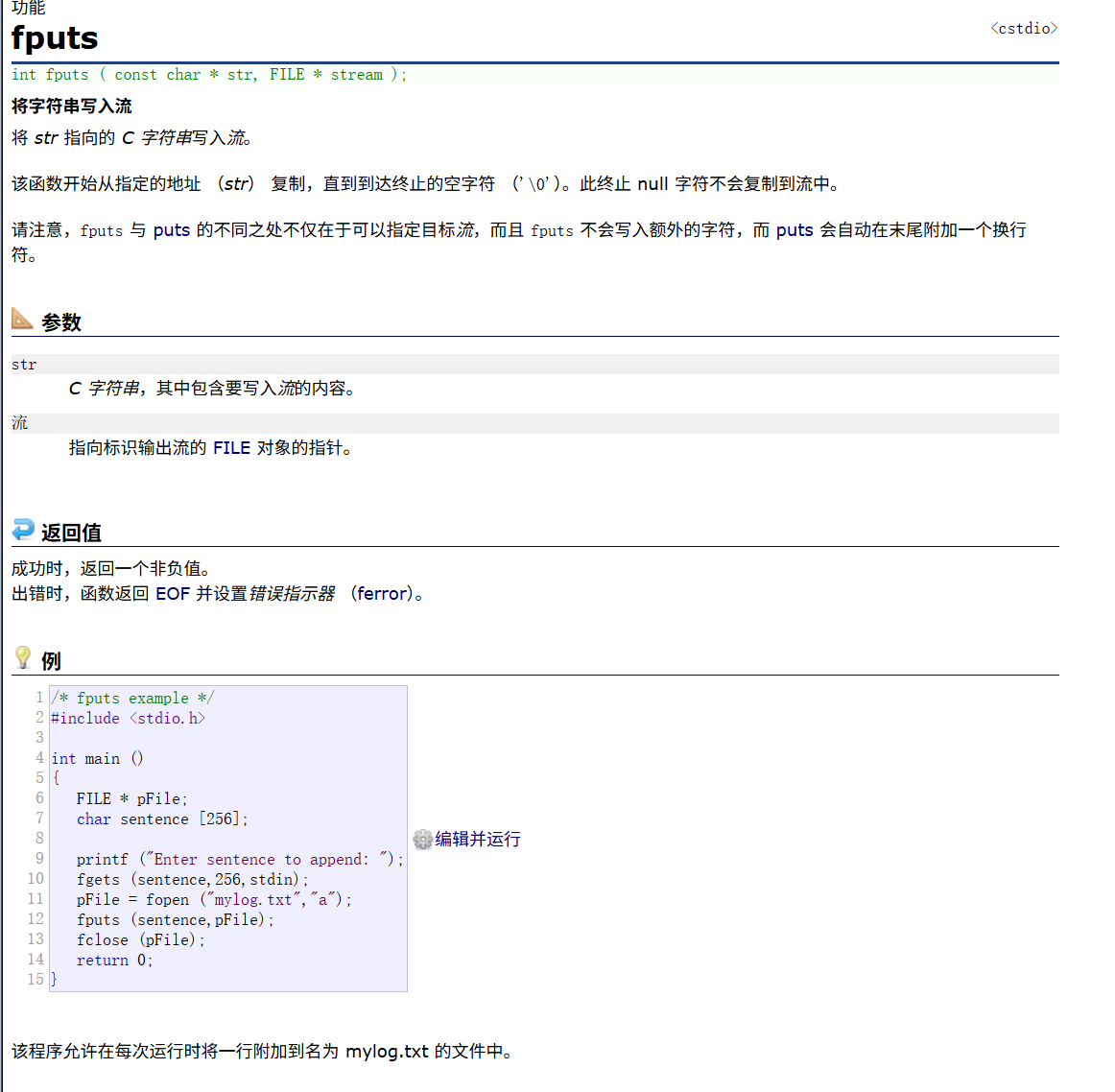
C
#define _CRT_SECURE_NO_WARNINGS
#include <stdio.h>
#include <stdlib.h>
int main(void)
{
//打开文件
FILE* ps = fopen("test.txt", "w");
if (ps == NULL)
{
perror("fopen");
return 1;
}
//写文件
fputs("hello world\n", ps);
fputs("hello bit\n", ps);
//关闭文件
fclose(ps);
ps = NULL;
return 0;
}也可以打印到屏幕上,用stdout输出流
C
fputc('a', stdout);2.5fprintf函数
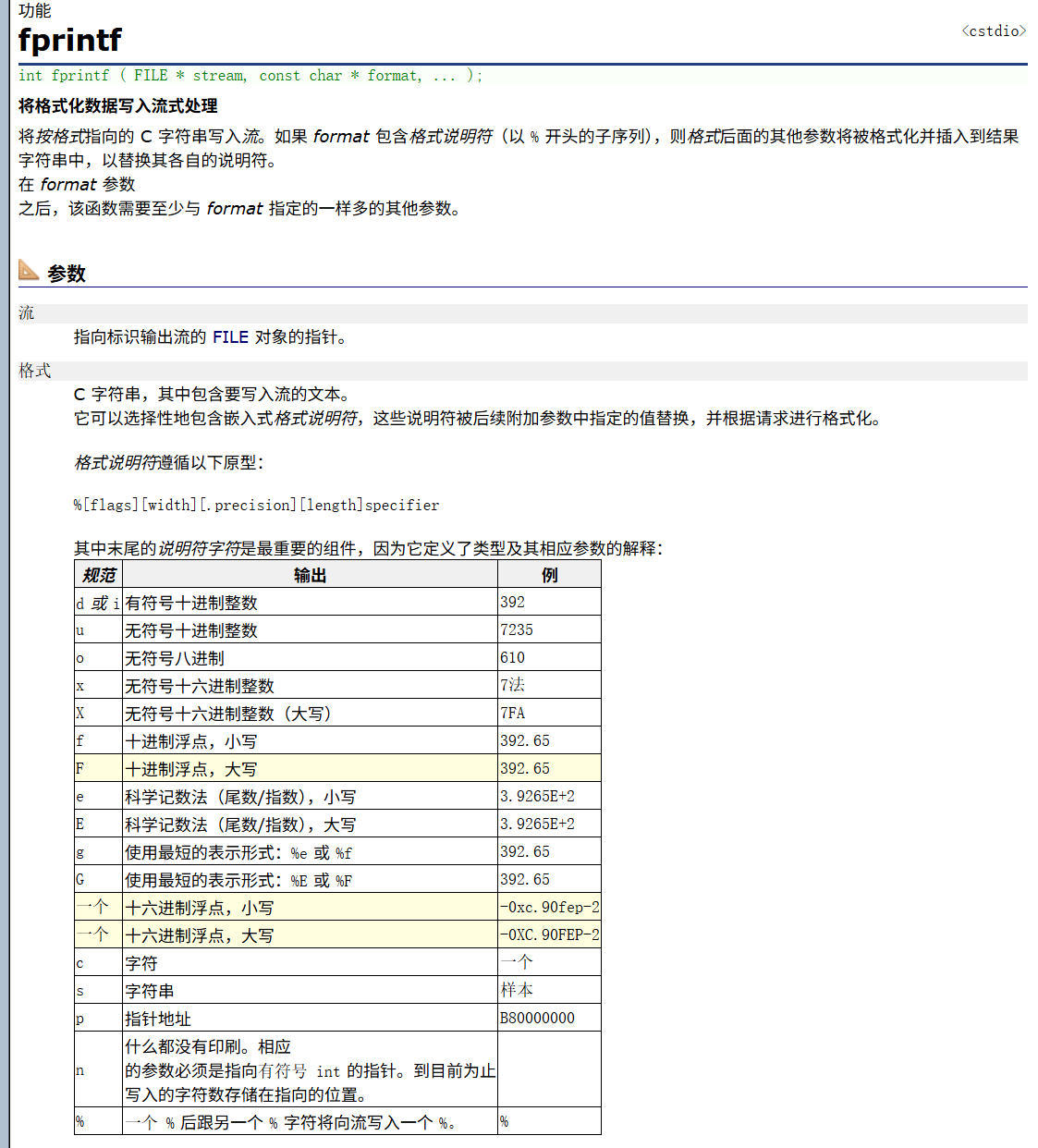
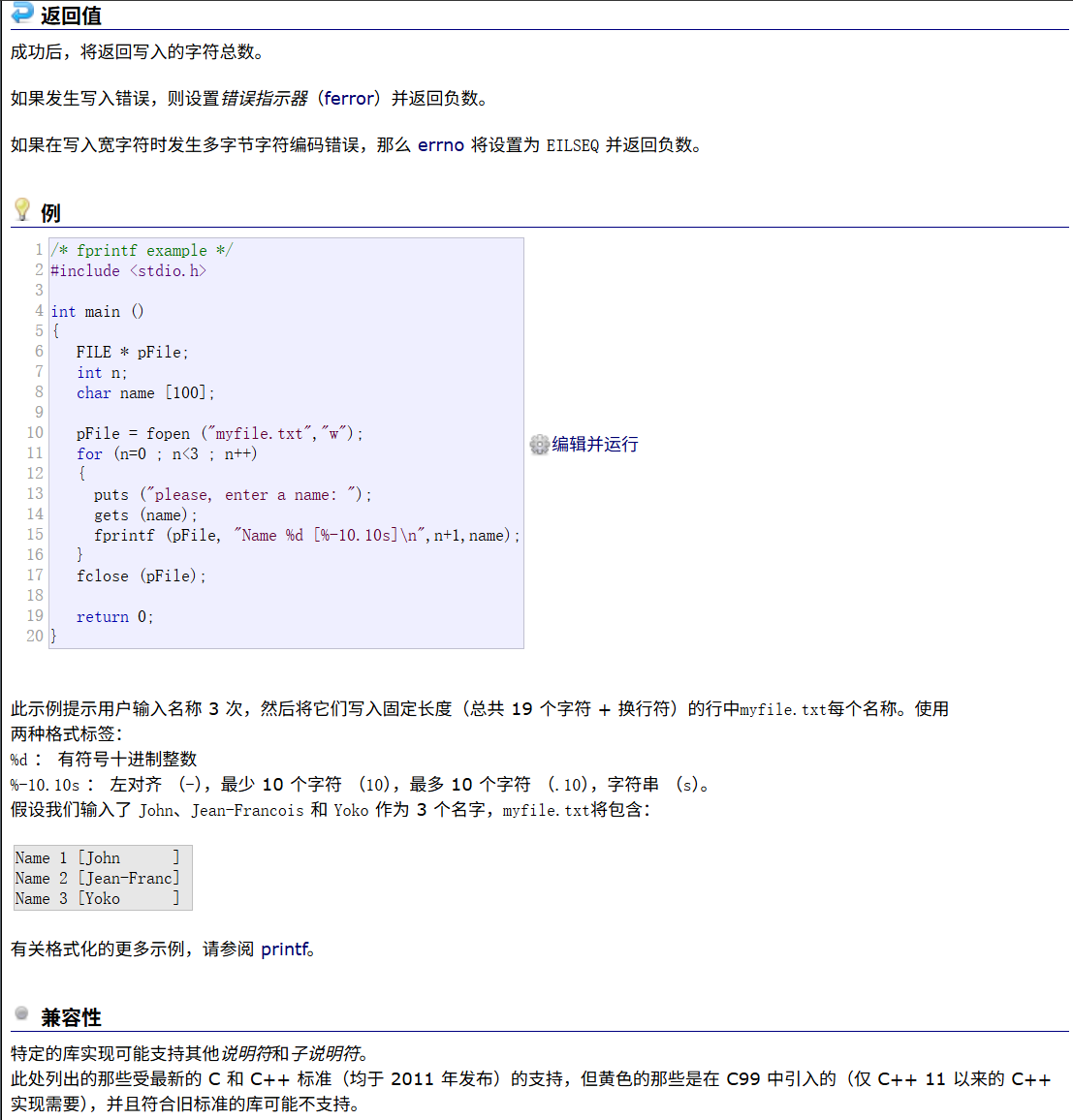
C
#define _CRT_SECURE_NO_WARNINGS
#include <stdio.h>
#include <stdlib.h>
struct Stu
{
char name[20];
int age;
float score;
};
int main()
{
//打开文件
FILE* pf = fopen("test.txt", "w");
if (pf == NULL)
{
perror("fopen");
return 1;
}
//写入
struct Stu s = { "张三",20,66.0 };
fprintf(pf, "%s %d %f", s.name, s.age, s.score);
//关闭文件
fclose(pf);
pf = NULL;
return 0;
}test.txt文件中显示:
张三 20 66.0也可以打印在屏幕上,只需要用stdout输出流即可
C
fprintf(stdout, "%s %d %f", s.name, s.age, s.score);屏幕上打印为:
张三 20 66.02.6fcanf函数
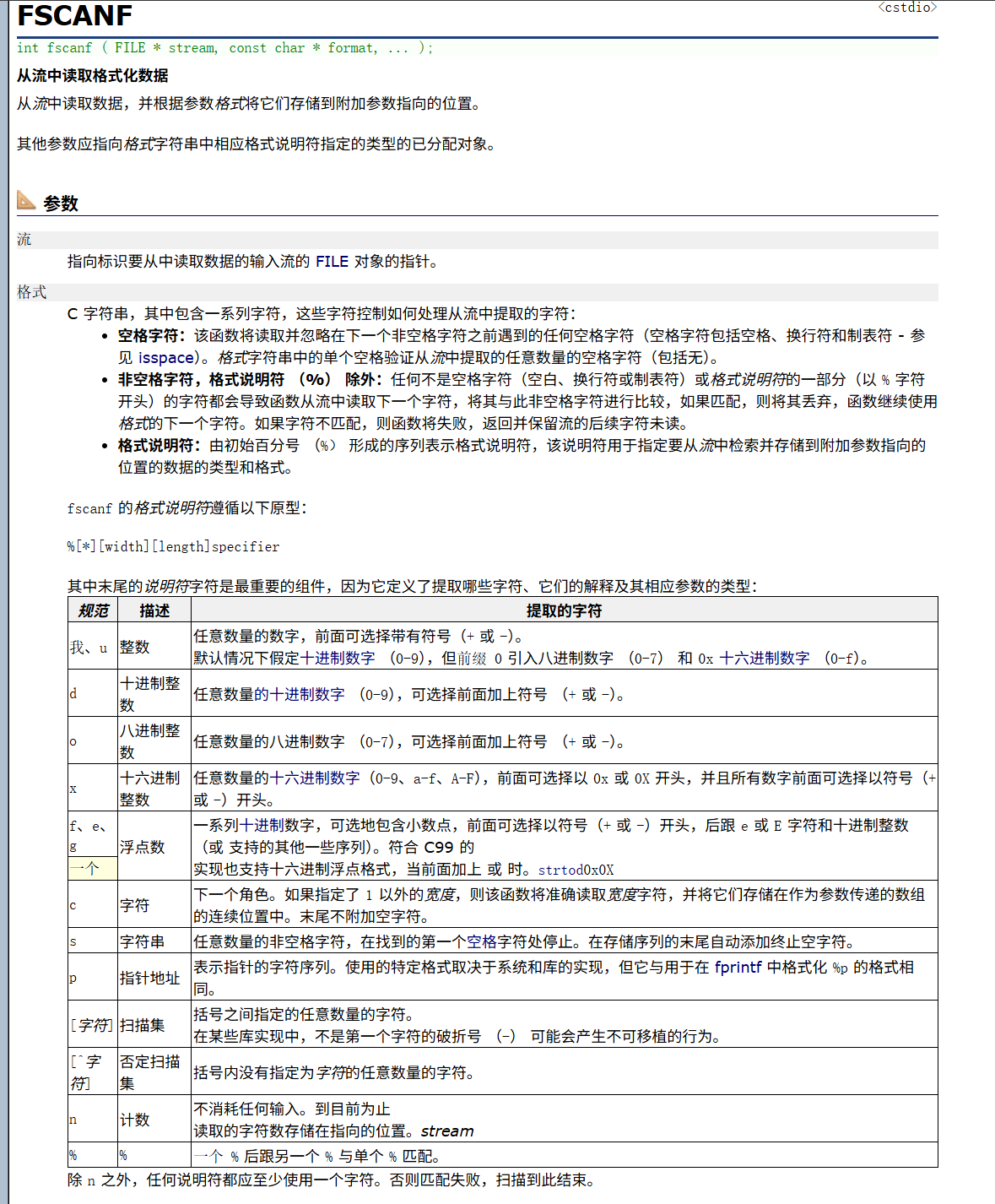
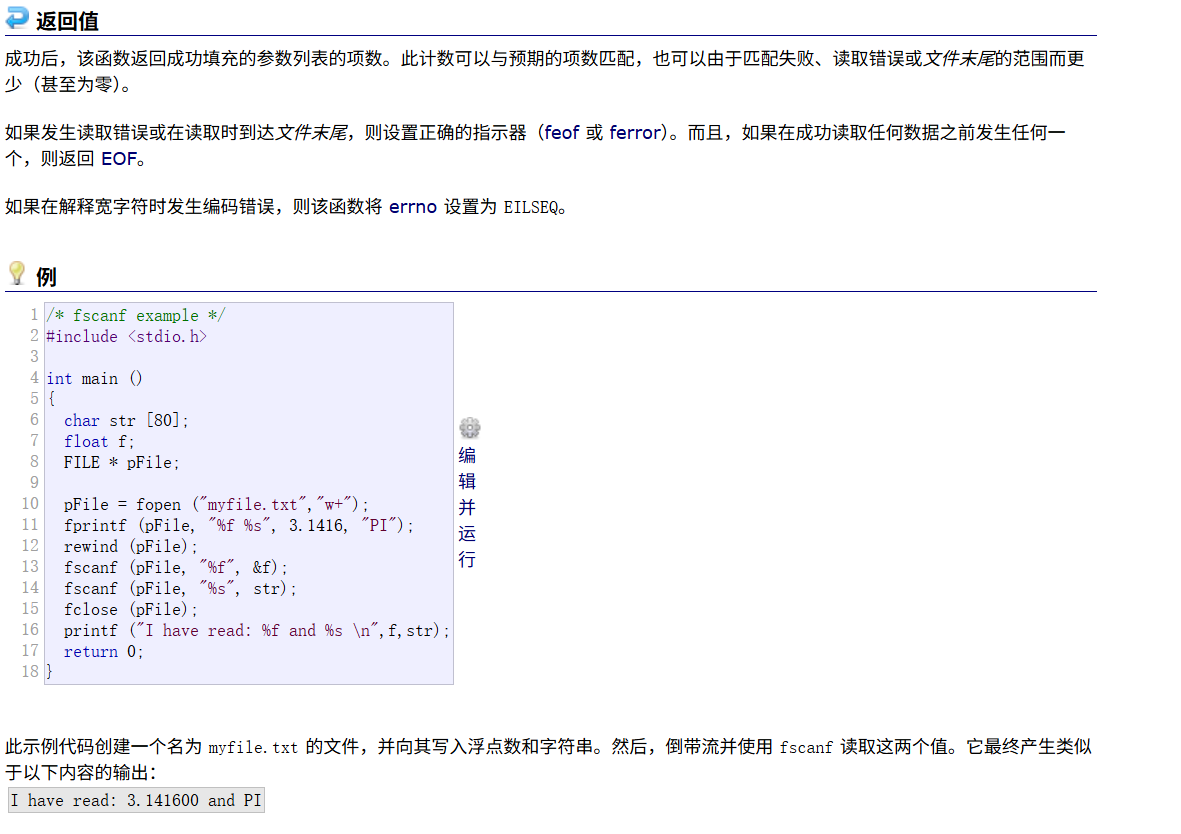
前面test.txt文本建立时,将文本里的数据拿出时,要用到fcanf来读取
C
#define _CRT_SECURE_NO_WARNINGS
#include <stdio.h>
#include <stdlib.h>
struct Stu
{
char name[20];
int age;
float score;
};
int main()
{
struct Stu s = { 0 };
//想从文件test.txt中读取数据放在s中
FILE* pf = fopen("test.txt", "r");
if (pf == NULL)
{
perror("fopen");
return 1;
}
//读文件
fscanf(pf, "%s %d %f", s.name, &(s.age), &(s.score));
//打印在屏幕上
printf("%s %d %f", s.name, s.age, s.score);
fclose(pf);
pf = NULL;
return 0;
}2.7sprintf函数与sscanf函数
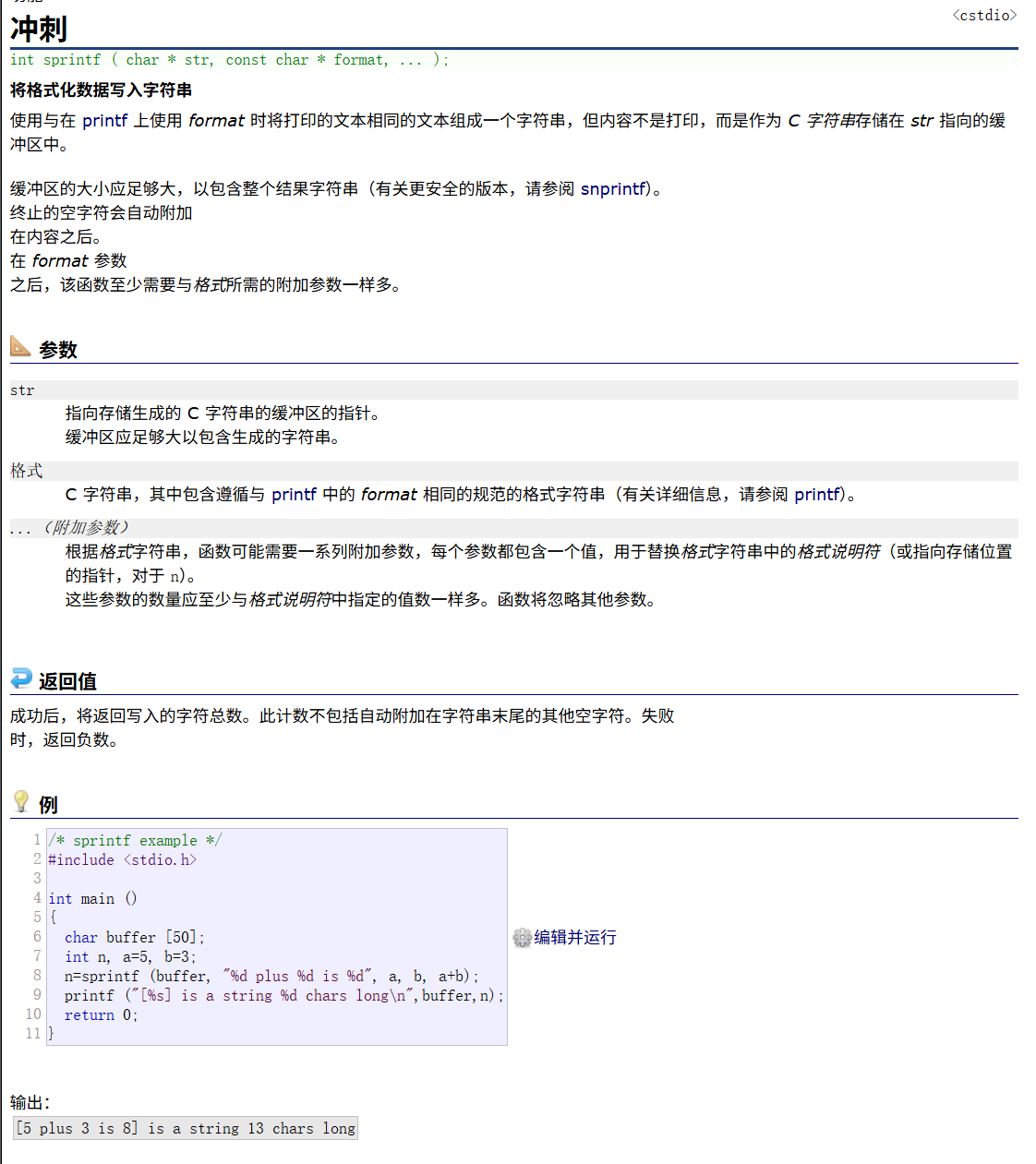
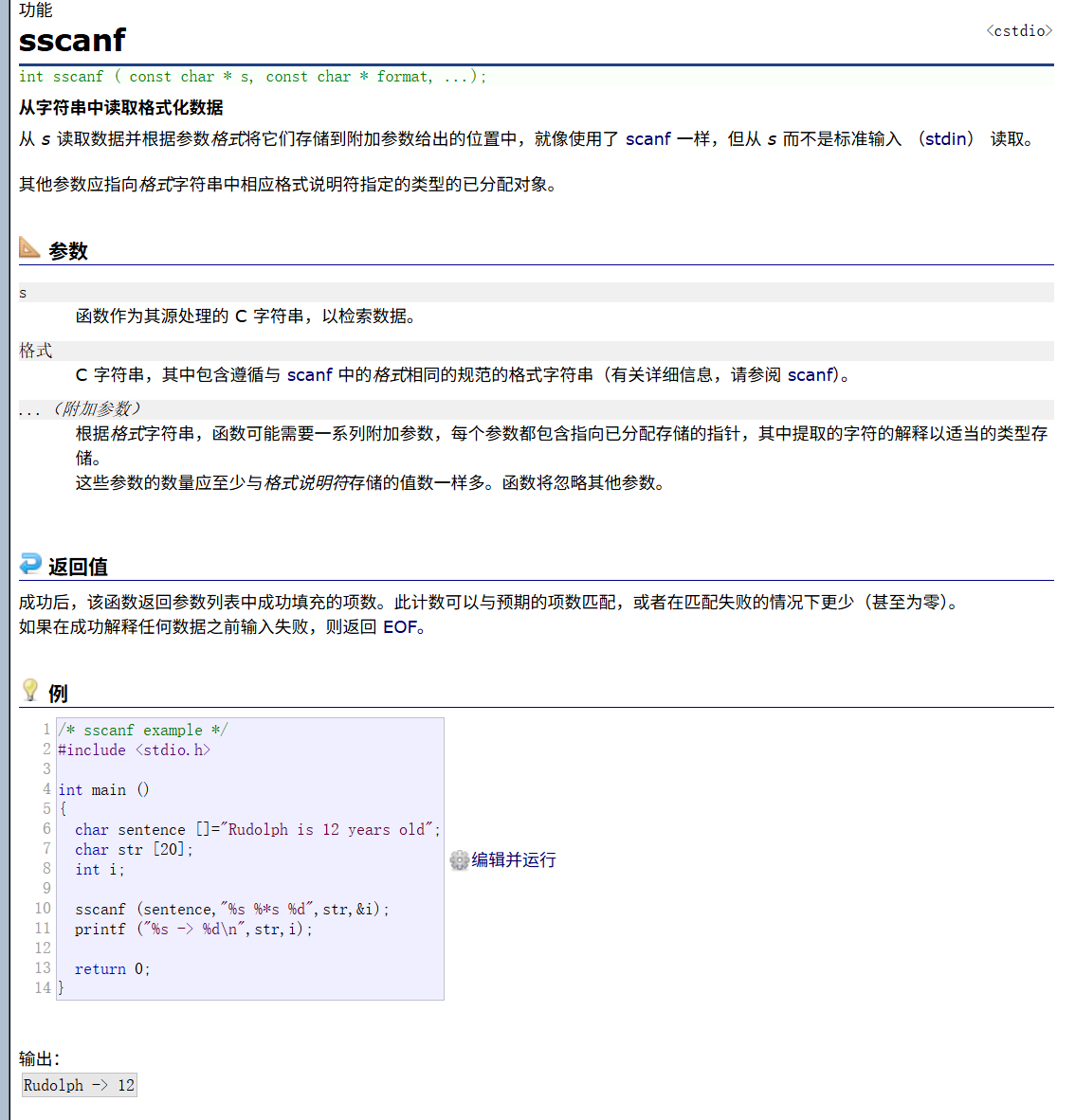
C
#define _CRT_SECURE_NO_WARNINGS
#include <stdio.h>
#include <stdlib.h>
struct Stu
{
char name[20];
int age;
float score;
};
int main()
{
char buf[200] = { 0 };
struct Stu s = { "张三", 20, 65.5f };
//转化成字符串
sprintf(buf, "%s %d %f", s.name, s.age, s.score);
//以字符串的形式打印
printf("1以字符串的形式:%s\n", buf); //1
struct Stu t = { 0 };
//读取buf字符串中的格式化的数据
sscanf(buf, "%s %d %f", t.name, &(t.age), &(t.score));
//以格式化形式打印
printf("2以格式化打印:%s %d %f\n", t.name, t.age, t.score); //2
return 0;
}2.8print与scanf大家族
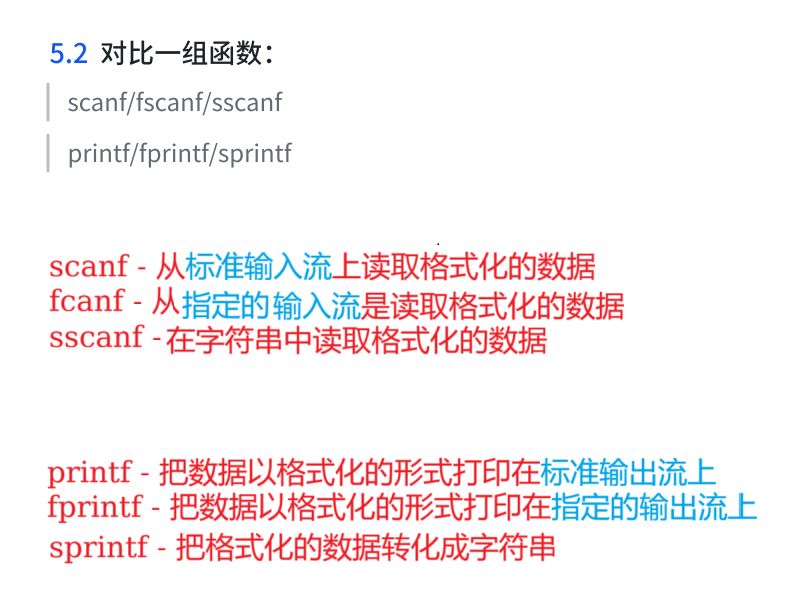
2.9fwrite函数
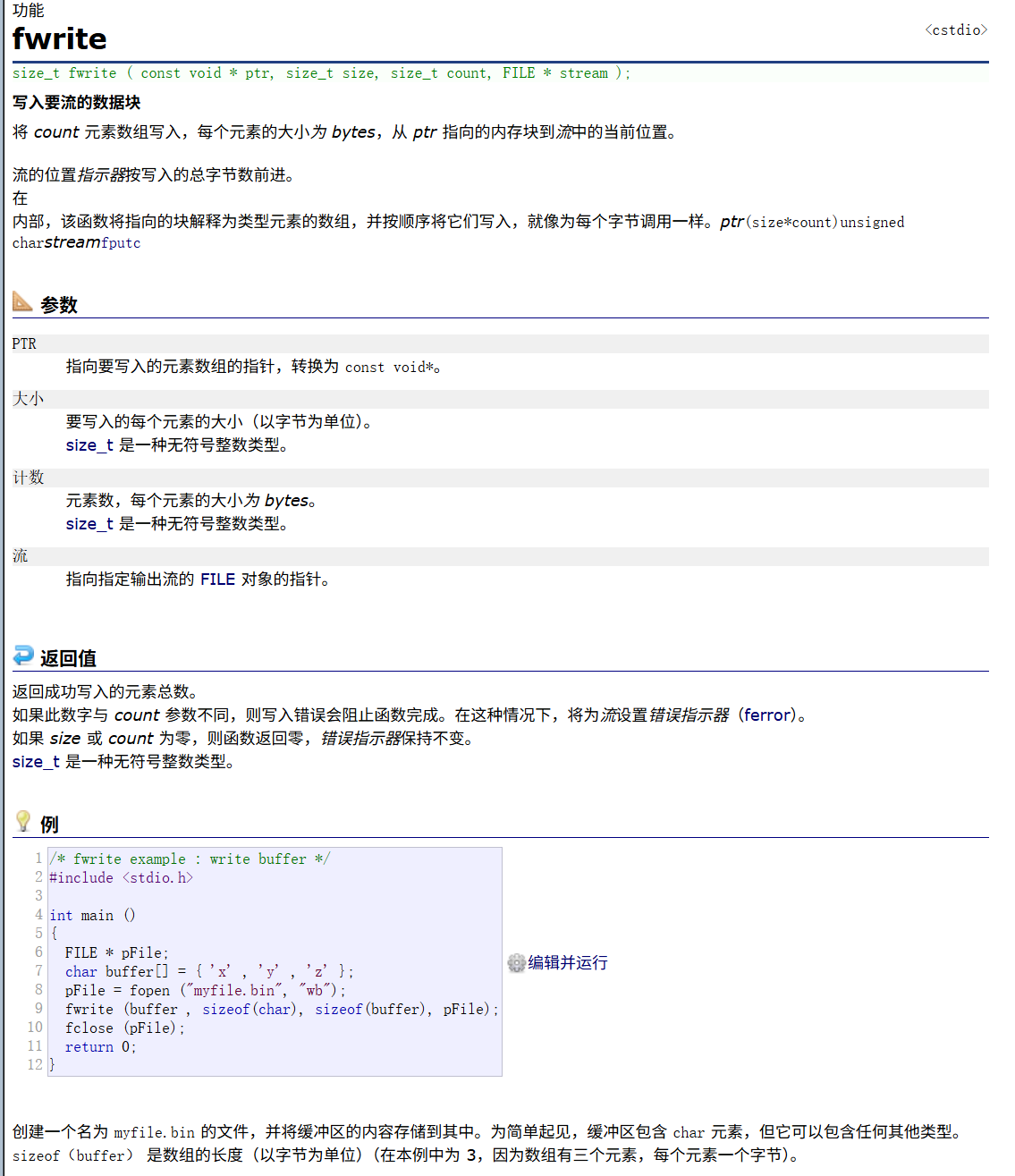
C
#define _CRT_SECURE_NO_WARNINGS
#include <stdio.h>
#include <stdlib.h>
struct Stu
{
char name[20];
int age;
float score;
};
int main()
{
int arr[5] = { 0 };
FILE* pf = fopen("test.txt", "wb");
if (pf == NULL)
{
perror("fopen");
return 1;
}
//写数据
int sz = sizeof(arr) / sizeof(arr[0]);
fwrite(arr, sizeof(arr[0]), sz, pf);
fclose(pf);
pf = NULL;
return 0;
}打印出乱码
2.10fread函数
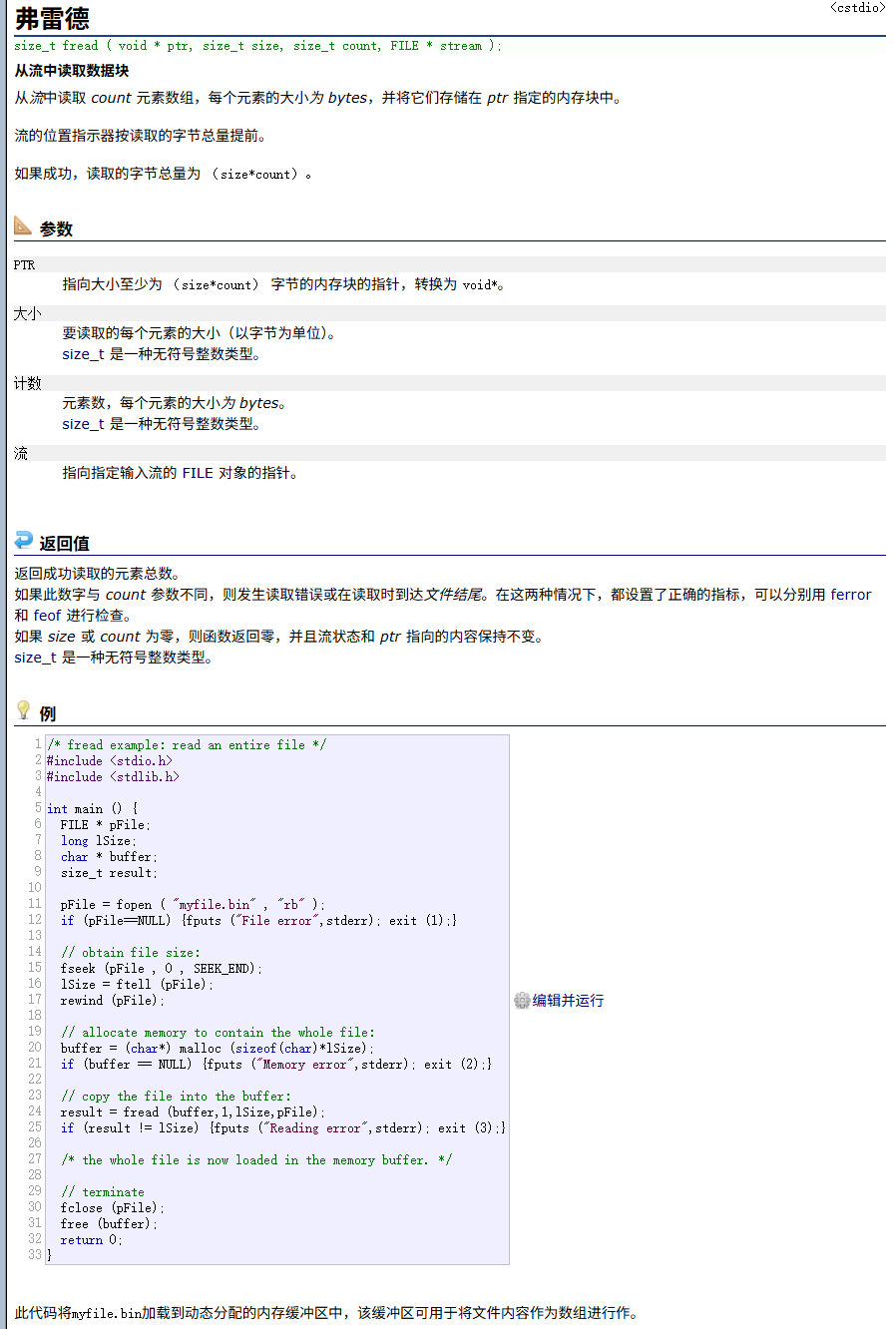
C
#define _CRT_SECURE_NO_WARNINGS
#include <stdio.h>
#include <stdlib.h>
struct Stu
{
char name[20];
int age;
float score;
};
int main()
{
int arr[5] = { 0 };
FILE* pf = fopen("test.txt", "rb");
if (pf == NULL)
{
perror("fopen");
return 1;
}
//读数据
fread(arr, sizeof(arr[0]), 5, pf);
int i = 0;
for (i = 0; i < 5; i++)
{
printf("%d ", arr[i]);
}
fclose(pf);
pf = NULL;
return 0;
}打印的结果为:
0 0 0 0 03、文件的随机读写
3.1fseek函数
根据文件指针的位置和偏移量来定位文件指针(文件内容的光标)!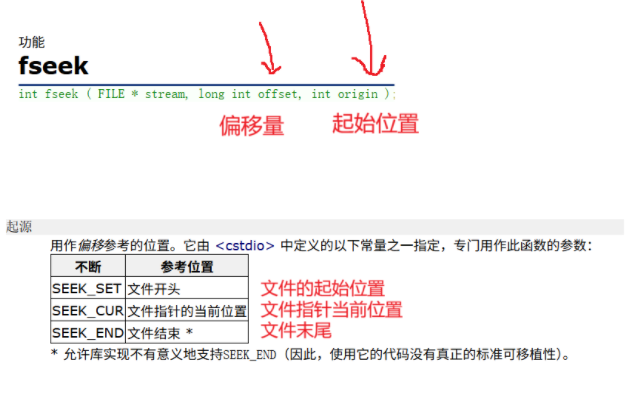

test.txt文件 :abcdefg
C
#define _CRT_SECURE_NO_WARNINGS
#include <stdio.h>
#include <stdlib.h>
int main()
{
//打开文件
FILE* pf = fopen("test.txt", "r");
if (pf == NULL)
{
perror("fopen");
return 1;
}
//读文件,移动4个字节,(SEEK_CUP)从起始位置开始
fseek(pf, 4, SEEK_CUR);
int ch = 0;
ch = fgetc(pf);
printf("%c", ch);
//关闭文件
fclose(pf);
pf = NULL;
return 0;
}打印的结果为:e
3.2ftell函数
返回文件指针相对于起始位置的偏移量
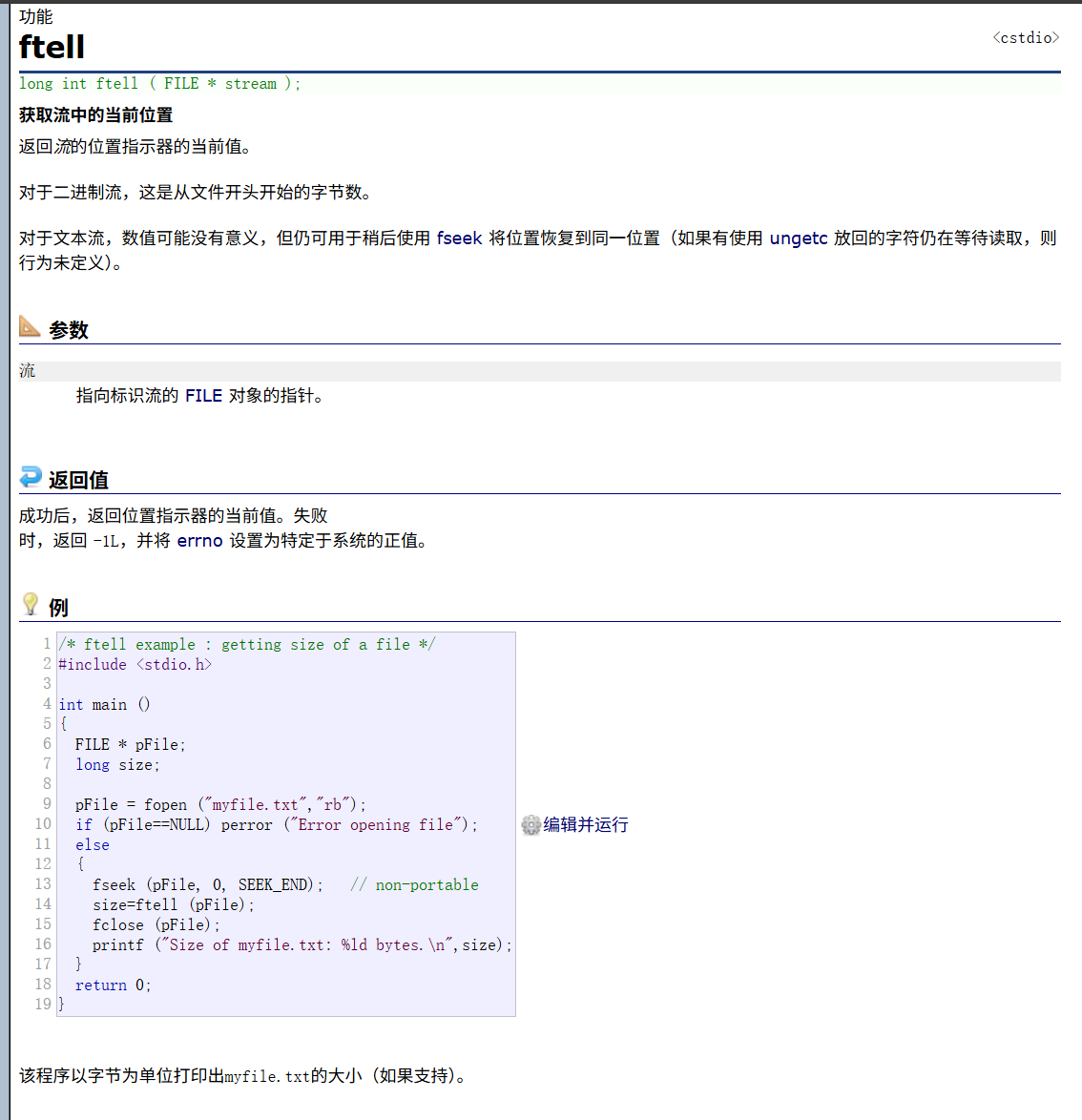
test.txt文件 :abcdefg
C
#define _CRT_SECURE_NO_WARNINGS
#include <stdio.h>
#include <stdlib.h>
int main()
{
//打开文件
FILE* pf = fopen("test.txt", "r");
if (pf == NULL)
{
perror("fopen");
return 1;
}
//读文件,移动4个字节,(SEEK_CUP)从起始位置开始
fseek(pf, 4, SEEK_CUR);
int ch = 0;
ch = fgetc(pf);
printf("%c\n", ch);
//偏移量
printf("%d\n", ftell(pf));
//关闭文件
fclose(pf);
pf = NULL;
return 0;
}打印的结果为:
e
53.3rewind
让文件指针的位置回到文件的起始位置
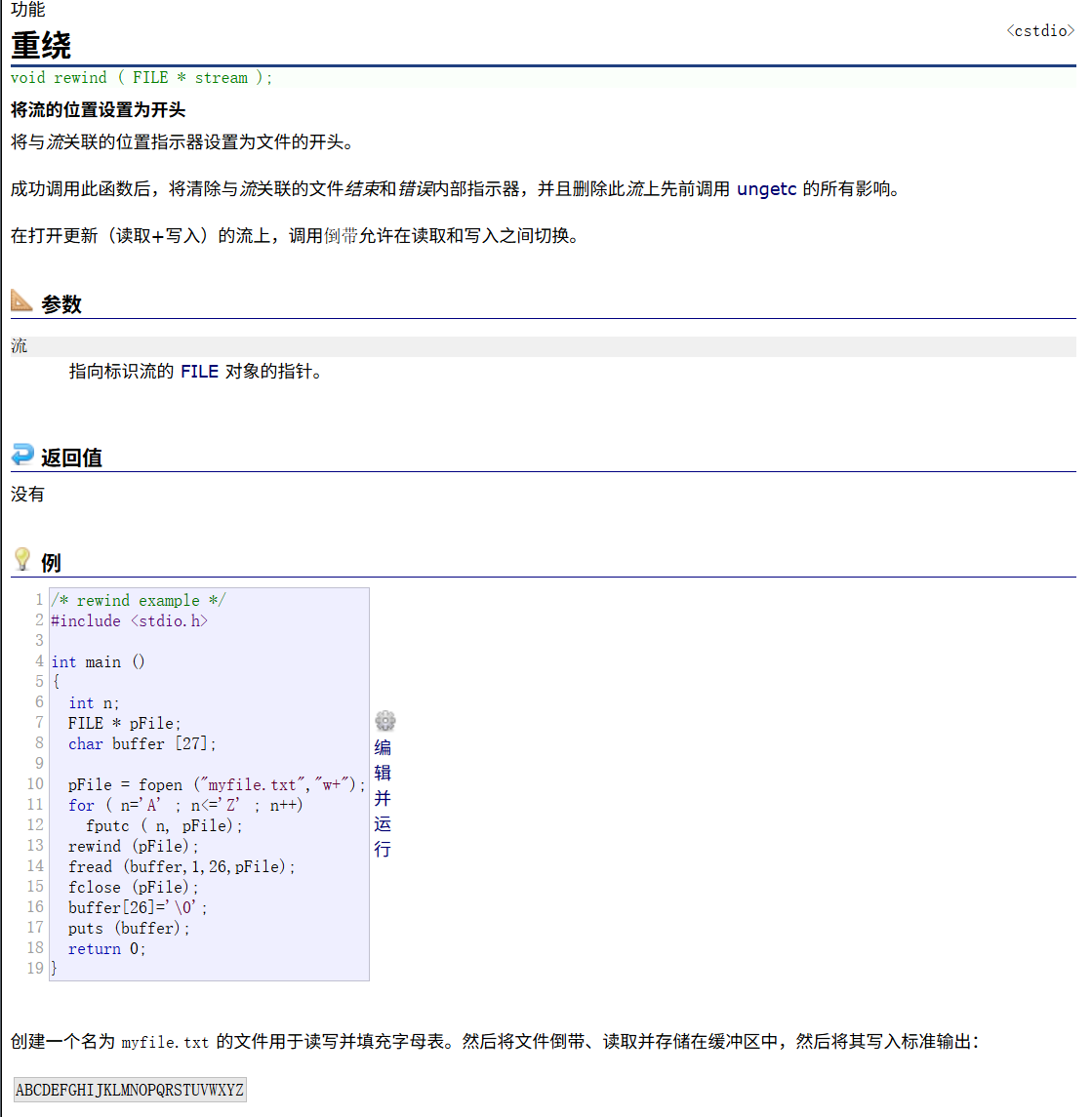
test.txt文件 :abcdefg
C
#define _CRT_SECURE_NO_WARNINGS
#include <stdio.h>
#include <stdlib.h>
int main()
{
//打开文件
FILE* pf = fopen("test.txt", "r");
if (pf == NULL)
{
perror("fopen");
return 1;
}
//读文件,移动4个字节,(SEEK_CUP)从起始位置开始
fseek(pf, 4, SEEK_CUR);
int ch = 0;
ch = fgetc(pf);
printf("%c\n", ch);
//偏移量
printf("%d\n", ftell(pf));//e
//起始位移量
rewind(pf);//5
//读文件
ch = fgetc(pf);
printf("%c\n", ch);//a
//关闭文件
fclose(pf);
pf = NULL;
return 0;
}4、文件读取结束的判定
4.1被错误使用的feof
牢记 :在文件读取过程中,不能用feof函数的返回值直接来判断文件的是否接受。
feof的作用是:当文件读取结束的时候,判断读取结束的元素是否是:遇到文件尾结束。
- 文本文件读取是否结束,判断返回值是否为
EOF(fgetc),或者NULL(fgets
)
fgetc函数:
- 如果读取正常,返回的是读取到字符的ASCLL码值
- 如果读取的过程中遇到文件末尾,或者发生错误,就返回EOF
fgets函数:
- 如果读取正常,返回的是存储读取到的字符串的字符数组的地址
- 如果读取的过程中遇到文件末尾,或者发生错误,返回NULL
- 二进制文件的读取结束判断,判断返回值是否小于世界要读的个数。
- fread判断返回值是否小于实际要读的个数
C
#define _CRT_SECURE_NO_WARNINGS
#include <stdio.h>
#include <stdlib.h>
int main()
{
//打开文件
FILE* pf = fopen("test.txt", "r");
if (pf == NULL)
{
perror("fopen");
return 1;
}
//读文件
int ch = 0;
while ((ch = fgetc(pf)) != EOF)
{
printf("%c\n", ch);
}
//判断是什么原因导致读取结束的
if (feof(pf))
{
printf("文件遇到末尾,读取正常结束\n");
}
else if (ferror(pf))
{
perror("fgetc");
}
//关闭文件
fclose(pf);
pf = NULL;
return 0;
}5、多文件复制
我们要把一个文件拷贝给另一个文件,可以用到上面学过的知识
C
#define _CRT_SECURE_NO_WARNINGS
#include <stdio.h>
#include <stdlib.h>
int main()
{
FILE* pin = fopen("test.txt", "r");
if (pin == NULL)
{
perror("fopen");
return 1;
}
FILE* pout = fopen("test2.txt", "w");
if (pout == NULL)
{
fclose(pin);
pin = NULL;
return 1;
}
int ch = 0;
while ((ch = fgetc(pin)) != EOF)
{
fputc(ch, pout);
}
fclose(pin);
fclose(pout);
pin = NULL;
pout = NULL;
return 0;
}